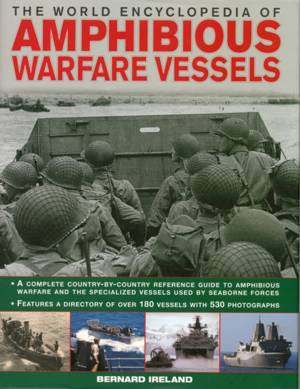
- Retrait gratuit dans votre magasin Club
- 7.000.000 titres dans notre catalogue
- Payer en toute sécurité
- Toujours un magasin près de chez vous
- Retrait gratuit dans votre magasin Club
- 7.000.0000 titres dans notre catalogue
- Payer en toute sécurité
- Toujours un magasin près de chez vous
World Encyclopedia of Amphibious Warfare Vessels
An Illustrated History of Modern Amphibious Warfare
Bernard Ireland
Livre relié | Anglais
25,45 €
+ 50 points
Description
Wars are decided definitively through the occupation of an enemy's territory. This is a task for military forces, which may have to be transported by sea. In extreme cases, as in the Pacific War of 1941-45, this may involve trans-oceanic passages. Thus is created the conflicting requirement for ships sufficiently large to undertake lengthy voyages, together with craft small enough to put an army and its equipment on to a beach that may be defended by a determined enemy.,
In the sailing navy, ships landed military contingents in special 'flatboats', the direct descendents of which were the 1940 LCAs, carried under davits by an LSI. In these were typified the two major categories of amphibious warfare vessel: the 'ship', travelling from shore to shore, and the 'craft', moving from ship to shore.,
This authoritative book details the development of amphibious warfare and, through the use of historical examples, illustrates its great range of scale, from raiding to full-scale invasion. It highlights the many coordinated activities necessary for a successful operation, from surveying and minesweeping to fire support, fighter direction and tri-service control.,
An illustrated directory of landing ships covers the ocean-going vessels that transport personnel, cargo or vehicles. It includes the most important amphibious vessels of today: float-on, float-off welldeck ships that are designed to operate landing craft large enough to handle main battle tanks.,
The next part of the book is a directory of landing craft, the majority of which, depending upon voyage length, will have been transported aboard specialist ships. World War II saw basic ramped craft joined by tracked amphibious vehicles. The imperatives of the nuclear age have seen the introduction of helicopters and high-speed air-cushion landing craft.,
This instructive volume, containing 530 photographs from museums, libraries and other historical sources, provides enthusiasts with a lively and engaging guide to this fascinating subject.,
Charts the complete history of amphibious warfare, including operations in Gallipoli, Dieppe, the Pacific, Normandy, Leyte Gulf, Iwo Jima, Vietnam, the Falklands and the Middle East,
Features a directory of landing ships, detailing conventional personnel and cargo carriers, welldeck ôdock shipsö and modern multi-function ships, accommodating helicopters, landing craft, military personnel, their vehicles and equipment,
Also features a directory of landing craft, from ramped beaching craft to present-day high-speed air-cushion craft, including amphibious tracked landing vehicles and peripheral activities such as minesweeping and obstacle clearance,
Specification boxes provide at-a-glance information about each vessel's country of origin, displacement, dimensions, armament, machinery, power and endurance,
Includes a glossary explaining naval acronyms, abbreviations and key terminology, and illustrated with more than 530 archive photographs,
In the sailing navy, ships landed military contingents in special 'flatboats', the direct descendents of which were the 1940 LCAs, carried under davits by an LSI. In these were typified the two major categories of amphibious warfare vessel: the 'ship', travelling from shore to shore, and the 'craft', moving from ship to shore.,
This authoritative book details the development of amphibious warfare and, through the use of historical examples, illustrates its great range of scale, from raiding to full-scale invasion. It highlights the many coordinated activities necessary for a successful operation, from surveying and minesweeping to fire support, fighter direction and tri-service control.,
An illustrated directory of landing ships covers the ocean-going vessels that transport personnel, cargo or vehicles. It includes the most important amphibious vessels of today: float-on, float-off welldeck ships that are designed to operate landing craft large enough to handle main battle tanks.,
The next part of the book is a directory of landing craft, the majority of which, depending upon voyage length, will have been transported aboard specialist ships. World War II saw basic ramped craft joined by tracked amphibious vehicles. The imperatives of the nuclear age have seen the introduction of helicopters and high-speed air-cushion landing craft.,
This instructive volume, containing 530 photographs from museums, libraries and other historical sources, provides enthusiasts with a lively and engaging guide to this fascinating subject.,
Charts the complete history of amphibious warfare, including operations in Gallipoli, Dieppe, the Pacific, Normandy, Leyte Gulf, Iwo Jima, Vietnam, the Falklands and the Middle East,
Features a directory of landing ships, detailing conventional personnel and cargo carriers, welldeck ôdock shipsö and modern multi-function ships, accommodating helicopters, landing craft, military personnel, their vehicles and equipment,
Also features a directory of landing craft, from ramped beaching craft to present-day high-speed air-cushion craft, including amphibious tracked landing vehicles and peripheral activities such as minesweeping and obstacle clearance,
Specification boxes provide at-a-glance information about each vessel's country of origin, displacement, dimensions, armament, machinery, power and endurance,
Includes a glossary explaining naval acronyms, abbreviations and key terminology, and illustrated with more than 530 archive photographs,
Spécifications
Parties prenantes
- Auteur(s) :
- Editeur:
Contenu
- Nombre de pages :
- 256
- Langue:
- Anglais
Caractéristiques
- EAN:
- 9780754820901
- Date de parution :
- 16-12-11
- Format:
- Livre relié
- Format numérique:
- Genaaid
- Dimensions :
- 239 mm x 306 mm
- Poids :
- 1614 g

Les avis
Nous publions uniquement les avis qui respectent les conditions requises. Consultez nos conditions pour les avis.






